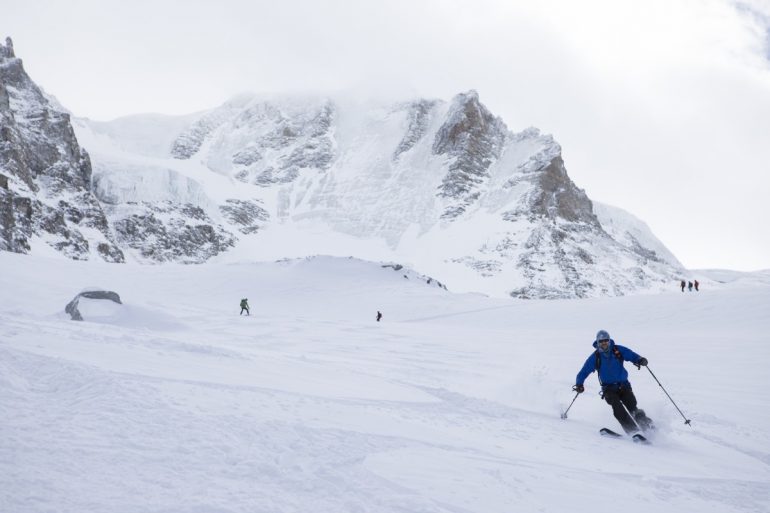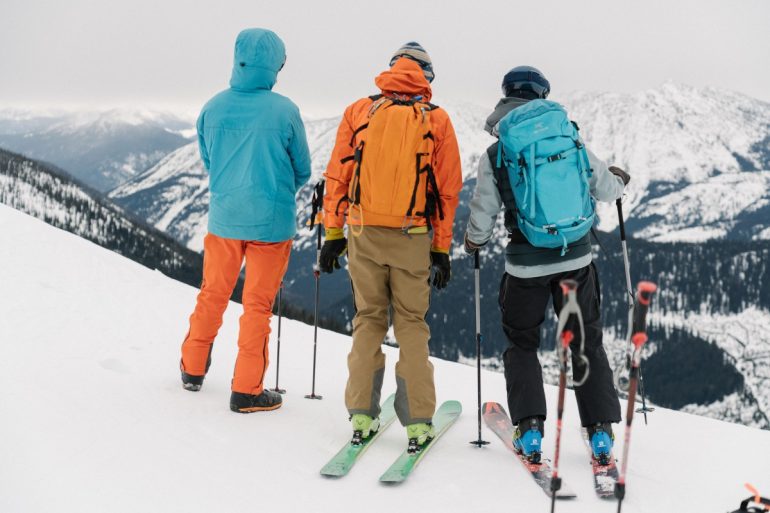
Sketchy snow in the high mountains? No stress, ski some 22-degree slopes (well) below! Gran Paradiso National Park in Italy, above the Chabod Hut. Photo: Matt Kennedy
“If avalanches are the problem, then terrain is the solution.” — Oft-repeated aphorism
Put down the pitchfork and take the price off my head. I’m not advocating you actually, literally, for-real ski without a beacon. No, over the ensuing paragraphs I’m only going to ask you to imagine skiing and riding without your basic avalanche safety equipment.
And why, you ask? Well, read on to find out, but in the meantime let me assure you of two things: one, I’m not above click-bait headlines and two, I’ve never skied backcountry without a beacon.
So, we cool here? Everybody properly equipped and ready to go? Bam, let’s click in and get going …
Solo Skiing and the No-Beacon Day
No exercise I can think of better teaches the concept of exposure than imagining that you’re skiing without a beacon. Solo skiing should achieve a similar effect.
I think we all agree, the easiest way to get smoked in the backcountry is avalanches. Sure, you can implode a knee on a stump, fall into a creek without your water-wings, get popsicle’d on an unplanned bivy in the Canadian cold, but for the most part, our biggest hazard in the backcountry is avalanches.
Avoiding this hazard really means eliminating exposure to it. Don’t want to lose money gambling? Don’t gamble. Not psyched on pancaking after jumping out of a plane? Don’t go skydiving. Eliminate exposure, eliminate the risk. Simple. Common sense.
Disclaimer
Again, I’m not telling you to solo-ski and certainly not to ditch your transceiver. I solo occasionally (and even on those days I bring safety gear), so I recognize some of us occasionally do it.
When in the mountains alone, it distills our awareness and focuses our attention, and why? Consciously or unconsciously, we recognize that even a tiny mistake will be far more serious if we’re alone. And if we agree that avalanches are the likeliest way to die in the backcountry, and that our only hope of surviving an avalanche is our team and an effective transceiver search and rescue, then skiing without teammates and a beacon leaves us two options: perfection and/or no-exposure riding.
Newsflash: none of us are perfect, so that leaves eliminating exposure.
The IDEA of the No Beacon Day
I remember several years ago, corresponding with a buddy who’s smarter and more experienced than me. I know, I know, you’re saying: “We’ve read your schtick before, that’s a pretty low bar, dude.”
Touché!
But this guy has a PhD in snow science, publishes articles filled with numbers and charts, and delivers speeches (to which people actually listen) at avy conferences. We were discussing skiing on a high-danger day and he made the remark, “It’s a no-beacon day.”
I pressed him on the idea and he said, “On a high-danger day, you need to ski as if you’re not wearing a beacon. You just can’t risk skiing in any avalanche terrain.”
Simple. No exposure, no problem.
Think about that for a moment. Not in avalanche terrain? You can’t get avalanched. That solves a lot — though not all — of our problems when we’re strapped to a board or fixed to skis. Sure, hazards still exist, but eliminate exposure to avalanches and we eliminate the chance to get injured, buried, or killed by an avalanche.
Just don’t ski in avalanche terrain. So simple … and yet, so difficult, too.

How many guides does it take to minimize exposure? Nate Goodman, the author, and Nino Guagliano (r) identify more and less exposed areas of an upcoming run. Keep in mind, good visibility is key to (accurately!) determining slope angle and distances. Flat light plays havoc on our visual acuity, which requires a larger safety margin between you and avalanche terrain and/or cornices. If in doubt, put some more distance between you and the hazard. Photo: Matt Kennedy
Terrain
First off, you better be sure-as-snot you know what is, and what isn’t, avalanche terrain. Are you in it? Connected to it, below it, anywhere near it? How far are avalanches running? Just a little, or full path and carving out new runout zones?
If you’re in the field and wondering whether you’re “in it,” then increase your margin … literally. Just put more distance between you and the questionable terrain. A cornice? Skin 10m farther from it than you think you need to. Crossing a runout? Easy — simply slide 20m into the trees, beyond the trim line and enjoy the shady embrace of old-growth timber.
Imagine skiing without a transceiver, for a sec. No-beacon skiing requires zero exposure. If you can’t be perfect, you better not play the game. You’re no longer worried about likelihood/probability of triggering a slide because you’re not in terrain that could slide. High danger, human-triggered avalanches certain? Fifty centimeters of rock salt at the base of the snowpack? Deep-slab instabilities?! No stress, not your problem. You’re not in avalanche terrain. Not under it, not connected to it. Simple!
Likelihood, Vulnerability, Consequence, Exposure
I use these terms frequently, but let’s rewind and consider them.
Likelihood and probability are interchangeable. How likely or probable is an avalanche? Wow, that is the 63-million-dollar question, eh? Sorry to say, another 20 years in this game and I still won’t have certainty on the matter. Patrollers throw bombs, thousands of skiers track up a slope, that oh-so-confident dude in the skintrack says “can’t happen today,” and none of that delivers 100-percent certainty. Decision-making based primarily on likelihood is a losing ball game, I’m sorry to say.
Vulnerability. I like long walks on the beach and true-life confessions as much as the next sensitive, new-age guy, but here we’re asking how vulnerable are we to avalanches? Pretty damn vulnerable. Wear a helmet, carry a beacon-shovel-probe, even strap on the balloon pack — at best they put a finger on the scale in your favor, but they’re no guarantee of nada. Sure, we use all these tools, but just ’cause your new Audi has airbags in every direction, are you willing to steer into oncoming traffic? We can tweak vulnerability a tiny bit with safety gear, but not very much and not all that reliably.
Imagining skiing without a beacon turns up the dial on vulnerability and therefore focuses us on mitigating hazard by other means (hint: consequences and exposure). So, vulnerability? Dead end here.
Our parents threatened us with consequences, some worse than others. Pull your sister’s hair again, you’re grounded for a month (which, to the eight-year-old brain is tantamount to death). Get sluffed above a cliff, you’re hosed. Consequences matter, so dial them back when you can. Avoid terrain traps, pay attention to the forecasted size of avalanches, and do your best. Remember, though, consequences are hard to estimate and people get killed in tiny avalanches all the time. Don’t bet the farm on estimating consequences.
No, your best and most effective dial to turn back while backcountry skiing is exposure. Are you in, or are you out, of avalanche terrain? And like I said above, skiing solo or (imagining) removing your beacon laser-focuses you on minimizing exposure.
Teaching and Learning
Unfortunately, too many courses and internet-aficionados (see: pit videos!) focus on trying to teach snowpack assessment; that is, estimating likelihood. Great endeavor for long-term learning, but might not be the best use of one’s time as a newer practitioner.
As luck would have it, one of the easier skills to teach a less experienced skier is terrain recognition. Way easier to teach than estimating likelihood of an avalanche. A more effective tool than showing students what to do if they’re avalanched (vulnerability). Simpler than judging consequences. And best of all, 100% effective: are you in, or are you out, of avalanche terrain?
Can you master it in a three-day, level 1? I doubt it, but man, you sure can give a person a great start on using guidebooks, maps (digital and analog), their eyeballs, and clinometers to identify and avoid avalanche terrain. Even snowshoers. (Sorry, couldn’t help myself — flame away, you lovers of the slowshoe!)
I bet you’re pretty good at it already. Vegetation clues of previous avalanches (bent trees, broken branches, flagged trees, no trees, etc)? Slope angle, can you reliably eyeball a slope — and the terrain it’s connected to — and determine if its start zone is below 30 degrees? Can you do it with a clinometer? How about using a slope-angle meter on a paper map to get a general idea of slopes to avoid and/or evaluate in the field?
And if the visibility goes to Hoboken, do you have the sense to dial it way back? Acknowledge that even Wonder Woman can’t judge slope angle in flat light, while looking straight-on? Swallow your pride, bucko, you’re skiing without a beacon and/or a partner, remember?! No exposure and no room for errors!
A good level 1 should introduce a process, incorporate the bulletin, and at least open the door to more learning down the road — but the one skill, I’d argue, more than almost any other, it should absolutely teach, is terrain recognition. Are you in, or are you out of, avalanche terrain?
Your Superpower
Here’s a little exercise — next time you read an avalanche accident, go to the bulletin and compare the terrain forecasters identified as hazardous, with the terrain in which the accident occurred. Spoiler: they’re often pretty damn similar if not outright identical. Had the riders simply eliminated exposure to that terrain on that day, they might have avoided the problem.
Knowing how and when to manage exposure is your superpower. Your 100-percent effective body armor and decision-making trump card.
Uncertainty
So when to deploy this unstoppable superpower? Everybody has different risk tolerances, so trying to dictate a rule when to eliminate exposure would be downright un-American. Or un-Canadian, or un-wherever you’re reading this. But you get it — you determine your “rules of engagement” for the backcountry. Consider, though, most people get the chop on Moderate and Considerable days.
A better strategy for invoking your superpower might be on those days where uncertainty creeps into your equation: team uncertainty, terrain, avalanche (read: persistent problems), or weather uncertainty. Maybe the best time to pull on the cape is when an intolerable level of uncertainty creeps into your tour.
Ah, indeed, you’ve identified a problem here: the people (read: dudes in their 20s) who most need to learn when to dial it back are the ones least able to acknowledge uncertainty. Sorry, boys, but I was a 20-something dude once, too. Overconfidence was the name of my game, unfortunately.
That’s a topic for another time, but yeah — I concede, acknowledging uncertainty and eliminating exposure don’t come easily for some of us. A functioning team, diligent tour-planning, and reading the bulletin can all help ID uncertainty, but we gotta be listening for it.
I’ll leave it at this — in the backcountry, the consequences of a mistake can be unforgiving and severe. Fatal, even. On days where the avalanche hazard, weather, and/or terrain present too much uncertainty, I’d recommend dialing back or entirely eliminating exposure. Choose an easier tour, simpler terrain, lower consequences, low-to-no exposure.
Stack the deck in your favor. Wear a beacon, tour with competent partners, but ask yourself — if I were alone and naked out here, would I still be skiing where I’m skiing? If the answer is “no,” then ask yourself why you’re there in the first place. The idea of no-beacon, solo-skiing might just save your hide one of these days.
Rob Coppolillo writes and guides from his home base in Chamonix, France. He’s the author of The Ski Guide Manual.
Rob Coppolillo is a mountain guide and writer, based on Vashon Island, in Puget Sound. He’s the author of The Ski Guide Manual.
